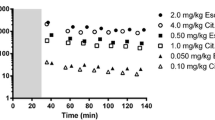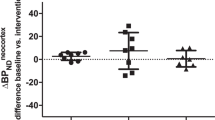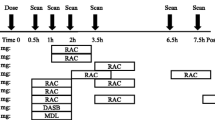Abstract
Background
Escitalopram is a dual serotonin reuptake inhibitor (SSRI) approved for the treatment of depression and anxiety disorders. It is the S-enantiomer of citalopram, and is responsible for the serotonin reuptake activity, and thus for its pharmacological effects. Previous studies pointed out that clinically efficacious doses of other SSRIs produce an occupancy of the serotonin reuptake transporter (SERT) of about 80% or more. The novel radioligand [123I]ADAM and single photon emission computer tomography (SPECT) were used to measure midbrain SERT occupancies for different doses of escitalopram and citalopram.
Methods
Twenty-five healthy subjects received a single dose of escitalopram [5 mg (n=5), 10 mg (n=5), and 20 mg (n=5)] or citalopram [(10 mg (n=5) and 20 mg (n=5)]. Midbrain SERT binding was measured with [123I]ADAM and SPECT on two study days, once without study drug and once 6 h after single dose administration of the study drug. The ratio of midbrain-cerebellum/cerebellum was the outcome measure (V3”) for specific binding to SERT in midbrain. Subsequently, SERT occupancy levels were calculated using the untreated baseline level for each subject. An E max model was used to describe the relationship between S-citalopram concentrations and SERT occupancy values. Additionally, four subjects received placebo to determine test–retest variability.
Results
Single doses of 5, 10, or 20 mg escitalopram led to a mean SERT occupancy of 60±6, 64±6, and 75±5%, respectively. SERT occupancies for subjects treated with single doses of 10 and 20 mg citalopram were 65±10 and 70±6%, respectively. A statistically significant difference was found between SERT occupancies after application of 10 and 20 mg escitalopram, but not for 10 and 20 mg citalopram. There was no statistically significant difference between the SERT occupancies of either 10 mg citalopram or 10 mg escitalopram, or between 20 mg citalopram and 20 mg escitalopram. E max was slightly higher after administration of citalopram (84%) than escitalopram (79%). In the test–retest study, a mean SERT “occupancy” of 4% was found after administration of placebo, the intraclass correlation coefficient was 0.92, and the repeatability coefficient was 0.25.
Conclusion
SPECT and [123I]ADAM were used to investigate SERT occupancies after single doses of escitalopram or citalopram. The test–retest study revealed good reproducibility of SERT quantification. Similar SERT occupancies were found after administration of equal doses (in respect to mg) of escitalopram and citalopram, giving indirect evidence for a fractional blockade of SERT by the inactive R-citalopram.



Similar content being viewed by others
References
Acton PD, Choi SR, Hou C, Plossl K, Kung HF (2001) Quantification of serotonin transporters in nonhuman primates using [123I]ADAM and SPECT. J Nucl Med 42(10):1556–1562
Alexopoulos GS, Privitera W, Ventura D, Bose A, Lenz SM, Wang Q (2004) Fixed dose of escitalopram (10 mg/day) and a flexible dosing regime of sertraline (50–200 mg/day) in a randomized, double-blind comparison in depressed patients. World J Biol Psychiatry 5(Suppl 1):97
Backstrom I, Bergstrom M, Marcusson J (1989) High affinity [3H]paroxetine binding to serotonin uptake sites in human brain tissue. Brain Res 486(2):261–268
Baumann P, Larsen F (1995) The pharmacokinetics of citalopram. Rev Contemp Pharmacother 6:287–295
Catafau AM, Perez V, Penengo MM, Bullich S, Danus M, Puigdemont D, Pascual JC, Corripio I, Llop J, Perich J, Alvarez E (2005) SPECT of serotonin transporters using 123I-ADAM: optimal imaging time after bolus injection and long-term test–retest in healthy volunteers. J Nucl Med 46(8):1301–1309
Chen F, Larsen MB, Sanchez C, Wiborg O (2003) The S-enantiomer of citalopram increases inhibitor binding to the human serotonin transporter by an allosteric mechanism. Comparison with other serotonin transporter inhibitors. Eur Neuropsychopharmacol 12:S217
Choi SR, Hou C, Oya S, Mu M, Kung MP, Siciliano M, Acton PD, Kung HF (2000) Selective in vitro and in vivo binding of [(125)I]ADAM to serotonin transporters in rat brain. Synapse 38(4):403–412
Erlandsson KT, Sivananthan D Lui, Spezzi A, Townsend CE, Mu S, Lucas R, Warrington S, Ell PJ (2005) Measuring SSRI occupancy of SERT using the novel tracer [123I]ADAM: a SPECT validation study. Eur J Nucl Med Mol Imaging 32(11):1329–1336
Frey R, Schreinzer D, Stimpfl T, Vycudilik W, Berzlanovich A, Kasper S (2000) Suicide by antidepressant intoxication identified at autopsy in Vienna from 1991–1997: the favourable consequences of the increasing use of SSRIs. Eur Neuropsychopharmacol 10(2):133–142
Frokjaer VG, Pinborg LH, Madsen H, Knudsen GM (2004) Evaluation of the serotonin transporter ligand [123I]ADAM for SPECT studies in humans. Neuroimage 22(Suppl 2):T176
Gorman JM, Kent JM (1999) SSRIs and SMRIs: broad spectrum of efficacy beyond major depression. J Clin Psychiatry 60(Suppl 4):33–38 (Discussion 39)
Gorman JM, Korotzer A, Su G (2002) Efficacy comparison of escitalopram and citalopram in the treatment of major depressive disorder: pooled analysis of placebo-controlled trials. CNS Spectr 7(4 Suppl):40–44
Kasper S (2004) Unique mechanism of action for escitalopram: does it hold the promise? Int J Psychiatry Clin Pract 8(Suppl 1):15–18
Kasper S, Heiden A (1995) Do SSRIs differ in their antidepressant efficacy? Hum Psychopharmacol 10:163–171
Kasper S, Vieira A, Schmidt R, Richter P (1990) Multiple hormone responses to stimulation with dl-fenfluramine in patients with major depression before and after antidepressive treatment. Pharmacopsychiatry 23(2): 76–84
Kasper S, Tauscher J, Willeit M, Stamenkovic M, Neumeister A, Kufferle B, Barnas C, Stastny J, Praschak-Rieder N, Pezawas L, de Zwaan M, Quiner S, Pirker W, Asenbaum S, Podreka I, Brucke T (2002) Receptor and transporter imaging studies in schizophrenia, depression, bulimia and Tourette’s disorder–implications for psychopharmacology. World J Biol Psychiatry 3(3):133–146
Kasper S, Spadone C, Verpillat P, Angst J (2006) Onset of action of escitalopram compared with other antidepressants: results of a pooled analysis. Int Clin Psychopharmacol 21(2):105–110
Kauppinen TA, Bergstrom KA, Heikman P, Hiltunen J, Ahonen AK (2003) Biodistribution and radiation dosimetry of [123I]ADAM in healthy human subjects: preliminary results. Eur J Nucl Med Mol Imaging 30(1):132–136
Klein N, Sacher J, Mossaheb N, Asenbaum S, Pötzi C, Dobrozemsky G, Dudczak R, Kasper S, Tauscher J (2004) Quantification of serotonin transporters with [123I]ADAM and SPECT in healthy human subjects: preliminary data on tracer kinetics. Biol Psychiatry 55:S212
Kugelberg F, Carlsson CB, Ahlner J, Bengtsson F (2003) Stereoselective single-dose kinetics of citalopram and its metabolites in rats. Chirality 15(7):622–629
Larsen F, Priskorn M, Overo KF (2001) Lack of citalopram effect on oral digoxin pharmacokinetics. J Clin Pharmacol 41(3):340–346
Larsen AK, Brennum LT, Egebjerg J, Sanchez C, Halldin C, Andersen PH (2004) Selectivity of 3H-MADAM binding to 5-hydroxytryptamine transporters in vitro and in vivo in mice; correlation with behavioural effects. Br J Pharmacol 141(6):1015–1023
Laruelle M, Baldwin RM, Malison RT, Zea-Ponce Y, Zoghbi SS, al-Tikriti MS, Sybirska EH, Zimmermann RC, Wisniewski G, Neumeyer JL et al (1993) SPECT imaging of dopamine and serotonin transporters with [123I]beta-CIT: pharmacological characterization of brain uptake in nonhuman primates. Synapse 13(4):295–309
Lepola UM, Loft H (2003) Reines EH Escitalopram (10–20 mg/day) is effective and well tolerated in a placebo-controlled study in depression in primary care. Int Clin Psychopharmacol 18:211–217
Lingjaerde O, Ahlfors UG, Bech P, Dencker SJ, Elgen K (1987) The UKU side effect rating scale. A new comprehensive rating scale for psychotropic drugs and a cross-sectional study of side effects in neuroleptic-treated patients. Acta Psychiatr Scand Suppl 334:1–100
Llorca PM, Azorin JM, Despiegel N, Verpillat P (2005) Efficacy of escitalopram in patients with severe depression: a pooled analysis. Int J Clin Pract 59(3):268–275
Malling D, Poulsen MN, Sogaard B (2005) The effect of cimetidine or omeprazole on the pharmacokinetics of escitalopram in healthy subjects. Br J Clin Pharmacol 60(3):287–290
Meyer JH, Wilson AA, Ginovart N, Goulding V, Hussey D, Hood K, Houle S (2001) Occupancy of serotonin transporters by paroxetine and citalopram during treatment of depression: a [(11)C]DASB PET imaging study. Am J Psychiatry 158(11):1843–1849
Meyer JH, McMain S, Kennedy SH, Korman L, Brown GM, DaSilva JN, Wilson AA, Blak T, Eynan-Harvey R, Goulding VS, Houle S Links P (2003) Dysfunctional attitudes and 5-HT2 receptors during depression and self-harm. Am J Psychiatry 160(1):90–99
Meyer JH, Wilson AA, Sagrati S, Hussey D, Carella A, Potter WZ, Ginovart N, Spencer EP, Cheok A, Houle S (2004) Serotonin transporter occupancy of five selective serotonin reuptake inhibitors at different doses: an [11C]DASB positron emission tomography study. Am J Psychiatry 161(5):826–835
Montgomery SA, Loft H, Sanchez C, Reines EH, Papp M (2001) Escitalopram (S-enantiomer of citalopram): clinical efficacy and onset of action predicted from a rat model. Pharmacol Toxicol 88(5):282–286
Moore N, Verdoux H, Fantino B (2005) Prospective, multicentre, randomized, double-blind study of the efficacy of escitalopram versus citalopram in outpatient treatment of major depressive disorder. Int Clin Psychopharmacol 20(3):131–137
Mork A, Kreilgaard M, Sanchez C (2003) The R-enantiomer of citalopram counteracts escitalopram-induced increase in extracellular 5-HT in the frontal cortex of freely moving rats. Neuropharmacology 45(2):167–173
Neumeister A, Bain E, Nugent AC, Carson RE, Bonne O, Luckenbaugh DA, Eckelman W, Herscovitch P, Charney DS, Drevets WC (2004) Reduced serotonin type 1A receptor binding in panic disorder. J Neurosci 24(3):589–591
Oya S, Choi SR, Hou, Mu M, Kung MP, Acton PD, Siciliano M Kung HF (2000) 2-((2-((dimethylamino)methyl)phenyl)thio)-5-iodophenylamine (ADAM): an improved serotonin transporter ligand. Nucl Med Biol 27(3):249–254
Pirker W, Asenbaum S, Kasper S, Walter H, Angelberger P, Koch G, Pozzera A, Deecke L, Podreka I, Brucke T (1995) beta-CIT SPECT demonstrates blockade of 5HT-uptake sites by citalopram in the human brain in vivo. J Neural Transm Gen Sect 100(3):247–256
Rochat B, Baumann P, Audus KL (1999) Transport mechanisms for the antidepressant citalopram in brain microvessel endothelium. Brain Res 831(1–2):229–236
Sacher J, Asenbaum S, Klein N, Geiss-Granadia T, Mossaheb N, Pötzi C, Attarbaschi T, Lanzenberger R, Dudczak R, Kasper S, Tauscher J (2006) [123I]ADAM: a novel SPECT ligand for quantification of serotonin transporters in humans. Int J Neuropsychopharmacology (in press)
Sanchez C, Kreilgaard M (2004) R-citalopram inhibits functional and 5-HTP-evoked behavioural responses to the SSRI, escitalopram. Pharmacol Biochem Behav 77(2):391–398
Sanchez C, Gruca P, Bien E, Papp M (2003a) R-citalopram counteracts the effect of escitalopram in a rat conditioned fear stress model of anxiety. Pharmacol Biochem Behav 75(4):903–907
Sanchez C, Gruca P, Papp M (2003b) R-citalopram counteracts the antidepressant-like effect of escitalopram in a rat chronic mild stress model. Behav Pharmacol 14(5–6):465–470
Sanchez C, Bogeso KP, Ebert B, Reines EH, Braestrup C (2004) Escitalopram versus citalopram: the surprising role of the R-enantiomer. Psychopharmacology (Berl) 174(2):163–176
Sidhu J, Priskorn M, Poulsen M, Segonzac A, Grollier G, Larsen F (1997) Steady-state pharmacokinetics of the enantiomers of citalopram and its metabolites in humans. Chirality 9(7):686–692
Storustovu S, Sanchez C, Porzgen P, Brennum LT, Larsen AK, Pulis M Ebert B (2004) R-citalopram functionally antagonises scitalopram in vivo and in vitro: evidence for kinetic interaction at the serotonin transporter. Br J Pharmacol 142(1):172–180
Tauscher J, Pirker W, de Zwaan M, Asenbaum S, Brucke T, Kasper S (1999) In vivo visualization of serotonin transporters in the human brain during fluoxetine treatment. Eur Neuropsychopharmacol 9(1–2):177–179
Tauscher J, Jones C, Remington G, Zipursky RB, Kapur S (2002) Significant dissociation of brain and plasma kinetics with antipsychotics. Mol Psychiatry 7(3):317–321
Willeit M, Praschak-Rieder N, Neumeister A, Pirker W, Asenbaum S, Vitouch O, Tauscher J, Hilger E, Stastny J, Brucke T, Kasper S (2000) [123I]-beta-CIT SPECT imaging shows reduced brain serotonin transporter availability in drug-free depressed patients with seasonal affective disorder. Biol Psychiatry 47(6):482–489
Acknowledgement
The study was supported by an unrestricted grant from H. Lundbeck A/S. The study was partially supported by the “Bürgermeisterfonds der Stadt Wien” PNr: 2180/03.
Author information
Authors and Affiliations
Corresponding author
Rights and permissions
About this article
Cite this article
Klein, N., Sacher, J., Geiss-Granadia, T. et al. In vivo imaging of serotonin transporter occupancy by means of SPECT and [123I]ADAM in healthy subjects administered different doses of escitalopram or citalopram. Psychopharmacology 188, 263–272 (2006). https://doi.org/10.1007/s00213-006-0486-0
Received:
Accepted:
Published:
Issue Date:
DOI: https://doi.org/10.1007/s00213-006-0486-0




